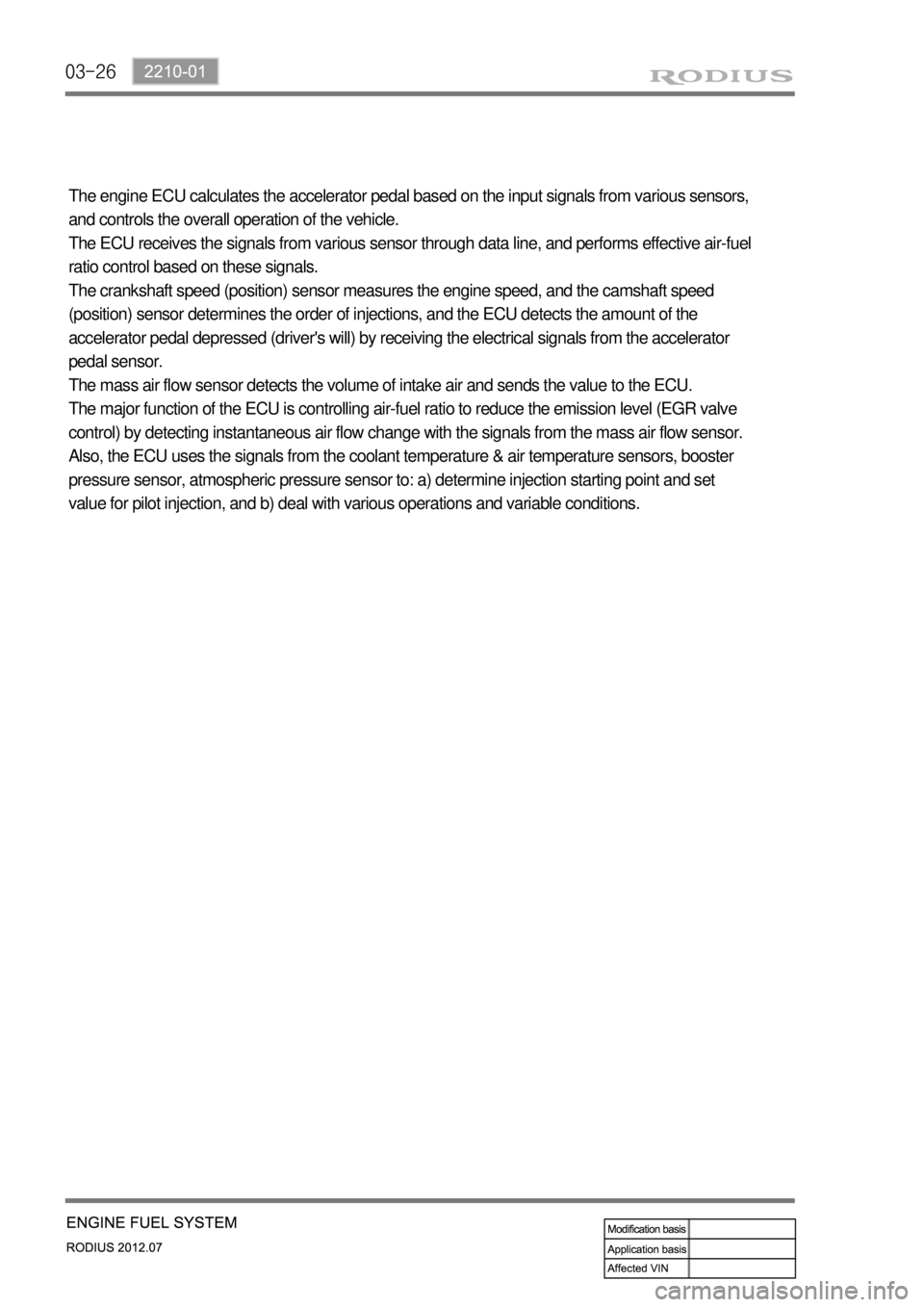Page 230 of 715

03-26
The engine ECU calculates the accelerator pedal based on the input signals from various sensors,
and controls the overall operation of the vehicle.
The ECU receives the signals from various sensor through data line, and performs effective air-fuel
ratio control based on these signals.
The crankshaft speed (position) sensor measures the engine speed, and the camshaft speed
(position) sensor determines the order of injections, and the ECU detects the amount of the
accelerator pedal depressed (driver's will) by receiving the electrical signals from the accelerator
pedal sensor.
The mass air flow sensor detects the volume of intake air and sends the value to the ECU.
The major function of the ECU is controlling air-fuel ratio to reduce the emission level (EGR valve
control) by detecting instantaneous air flow change with the signals from the mass air flow sensor.
Also, the ECU uses the signals from the coolant temperature & air temperature sensors, booster
pressure sensor, atmospheric pressure sensor to: a) determine injection starting point and set
value for pilot injection, and b) deal with various operations and variable conditions.
Page 260 of 715
06-191914-01
2. COMPONENTS
Atmospheric pressure, RPM
signal <00510047006d009600990047008b008c009b008800900093009a0047008800890096009c009b0047008a00960095009b009900960093004700930096008e0090008a005300470099008c008d008c00990047009b00960047006a008f00880097009b008c00
99004702c8006c0095008e00900095008c0047006a00960095>trol”.
E-VGT turbocharger
Improves engine powerAccelerator pedal position
sensor
Transfers driver's will to
accelerate to ECUEngine ECU (D20DTR)
E-VGT duty control
Coolant temperature sensor
Operates the VGT according
to engine warm-upHFM sensor
Improves the engine powerT-MAP sensor
Booster pressure and
temperature
Page 270 of 715
08-51520-00
1) Coolant Level Check
Park the vehicle on level ground and apply the parking brake. Stop the engine and wait until it is
cooled down.
The coolant level should be between the MAX and MIN mark on the coolant reservoir.
Check the coolant level. If the level is below the “MIN” mark, immediately add coolant. 1.
2.
Scalding hot coolant and steam could be blown out under pressure, which could cause
serious injury. Never remove the coolant reservoir cap when the engine and radiator are hot.
Avoid any direct contact of the coolant to the painted body of the vehicle. -
-
Page 272 of 715

08-71520-00
3. CAUTIONS
If 100% of anti-freeze is added, the water pump vane can be damaged and thermal
conductivity can be decreased resulting in poor circulation in the cooling system which leads
to overheated engine.
Use of non-recommended coolant could cause damage to the cooling system and
overheating of the engine.
Opening the coolant reservoir cap while the engine is running or hot can cause burns by hot
steam or water.
To open the coolant reservoir cap, wrap the cap with a wet towel or thick cloth after the
engine is cooled down sufficiently.
If cool water is added to the heated engine, the engine or radiator can be deformed.
The anti-freeze in the coolant can damage the painted surface, so avoid the contact of the
coolant to the painted body.
The anti-freeze and water should be mixed in proper mixture ratio. Never add only water
when adding coolant.
If the anti-freeze content is too low, the coolant can be frozen while the engine can be
overheated if anti-freeze content is too high. -
-
-
-
-
-
-
-
Page 273 of 715
08-8
Coolant reservoir
Oil filter module
Thermostat
When the engine coolant
reaches 90℃, the thermostat
starts to open (fully open at
100℃) and lets the coolant
flow to the radiator to
maintain the engine
temperature.
Water pump
The water pump is driven by the engine drive belt and
supplies the coolant to each area of the engine.
1. SYSTEM DESCRIPTION
1) Overview
Water pump Impeller vaneSealing
Page 274 of 715
08-91520-00
Coolant temperature sensor
Measures the coolant
temperature and sends the
result to the engine ECU.
Electric fan
Circulates the fresh air forcibly to exchange
heat with the radiator core fin.
Radiator
Releases heat through fins and cools down the hot
coolant as the coolant passes through the tube of
the radiator core.
Page 287 of 715
10-4
1. OVERVIEW
The pre-heating system for D20DTR engine has the glow plug to the cylinder head (combustion
chamber), and improves the cold start performance and reduces the emission level.
The pre-heating resistor (air heater) is used to heat the intake air.
This enables the diesel fuel to be ignited in low temperature condition.
The ECU receives the information such as, engine rpm, coolant temperature, engine torque, etc.,
through CAN communication during pre-heating process; and the pre-heating control unit
controls the pre-heating, heating during cranking and post-heating by the PWM control.
Glow plug
Engine ECU (D20DTR)Glow indicator
Glow plug control unit
(GCU)
Page 290 of 715
10-71413-00
4) Operation
Glow plug is installed in the cylinder head. It enhances the cold starting performance and reduces
the exhaust gas during cold starting.
ECU receives the data (engine rpm, coolant temperature, vehicle speed) through CAN lines.
Based on the data, GCU controls the pre-glow, cranking and post-glow. It also checks the glow
plugs, and sends the result to ECU.
(1) Temperature/Current Properties of GCU
GCU increases the temperature of glow plug very rapidly (approx. 2 seconds up to
1000°C)
FETs (similar to transistor) for each cylinder are integrated in GCU. During the pre-
glow period, battery voltage is supplied to the glow plugs directly to heat them rapidly.
After getting the desired temperature by pre-glowing, the temperature is controlled by
duty ratio. Step 1:
Step 2 & 3:
Step 4:
This shows the supplying voltage and time by GCU in each step. The step 4 is the period to
keep the temperature. -Step 1: I1
Step 2: I2
Step 3: I3
Step 4: I4